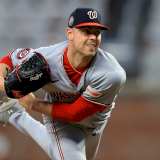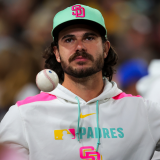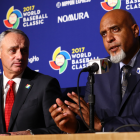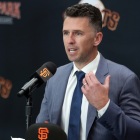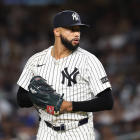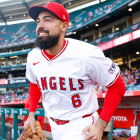
Washington Nationals 2017 season preview: A Harper rebound key to World Series run
Can the reigning NL East champs take home the flag again?

Download the CBS Sports App today and get the latest scores, news and alerts from Major League Baseball, plus get daily MLB picks from SportsLine!
The Washington Nationals last season bounced back from a disappointing 2015 to win the National League East -- a division that yielded two playoff teams -- by a full eight games. Along the way, they won 95 games and made the postseason for the third time in the last five years. Unfortunately for the Nats, said trip to the postseason once again culminated in an NLDS loss.
Yes, Max Scherzer took home NL Cy Young honors, Trea Turner proved to be a rookie thunderbolt, and Dusty Baker proved a much steadier dugout hand than Matt Williams. Other positives include Daniel Murphy’s highly productive season, and Anthony Rendon’s return to health. On the downside, Bryce Harper endured a significant decline from his 2015 MVP form.
As for the winter, the Nats swung a costly trade for Adam Eaton, and then they swooped in and signed Matt Wieters to a reasonable contract after the market treated him coldly. He becomes the Nats’ primary catcher, and he brings with him some power potential but also a questionable defensive reputation.
Now let’s take a deeper dive into a team that on paper looks like one of the NL’s best ...
The vitals
- 2016 record: 95-67
- 2017 schedule: click here
- 2017 depth chart: click here
Will Bryce Harper bounce back?
For as long as he’s been a part of the sport’s consciousness, Harper is still just 24 years of age. Given his youth and generational baseball skills, what he authored in 2015 -- 42 homers, a 198 OPS+, and a unanimous win in the NL MVP balloting -- was (unfairly) what we expected of him all along. So when he tumbled from those heights last season to be “merely” pretty good, it was a jolt to our assumptions about Harper. The 2017 season is thus a bit of a proving ground for him.
Is he going to get back to the track toward inner-circle greatness that he was on this time a year ago, or is he going to settle in as a quality yet objectively disappointing contributor? The Nats in 2016 proved they can thrive with Harper at less than his best, but the return of an idealized Harper to this already strong roster positions Washington as perhaps the best on-paper team in baseball.
To that end, there’s cause for hope. Just as the decline of a great player is not linear, neither is the rise of what we think will be a great player. It’s entirely possible that Harper resumes his expected arc for no other reason than baseball is a weird game played by imperfect young men. On more tangible fronts, there’s cause for optimism.
While the team dismissed the report, Tom Verducci reported last season that Harper had been dealing with a shoulder injury that compromised his swing. That would certainly explain a large measure of his 2016 struggles, and that would also explain this exit-velocity decline (via Brooks Baseball) ...
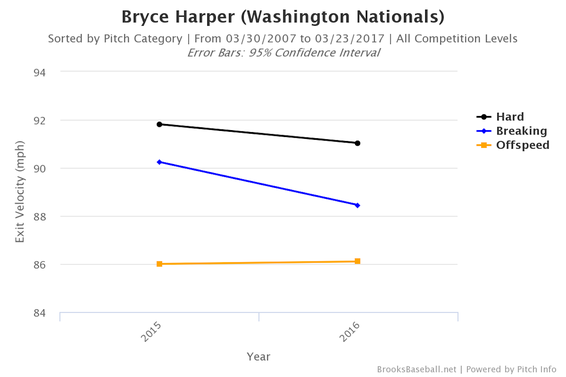
As you can see, Harper wasn’t hitting the ball as hard last season against fastballs and breaking balls. That’s a recipe for decline. In matters related, his rate on soft-hit balls reached a career high in 2016 (and that’s not a career high you want to be setting). His steep drop in batting average on balls in play and in his home runs as a percentage of fly balls suggest bad luck, but those trends can also suggest a player who’s simply not hitting the ball with as much authority.
That Harper saw so much decline in his power numbers while also making contact at career-best rates may be the result of a more muted swing -- necessitated by injury. It makes sense that the Nats wouldn’t cop to his injury heading into the playoffs -- why give potential opponents more intelligence on how to attack what should be your best hitter? -- but the possibility of shoulder woes explains a lot.
Assuming he’s over those shoulder woes, improvement can plausibly be expected. That’s not to say he’s going to run an OPS+ of 200 or so again. It’s not unusual for a player’s best season to occur in early in his career, and that’s especially the case these days, when some players -- thanks perhaps to improved conditioning and skills training coming up the rungs and more practice and game hours as amateurs -- arrive almost at their best. However, even if Harper stakes out a middle ground between his 2015 and 2016 levels of performance, he’ll be an All-Star and an MVP contender. It says here that’s what he’ll be going forward, if healthy.
The health of Stephen Strasburg
We all know that Strasburg has ace stuff and very often ace results when he’s healthy. That last qualifier, though, is a big one.
Strasburg’s spent parts of seven seasons in the majors, and in only one of those has he logged a qualifying number of innings. He’s also been a contributor to three Nats teams that went on to make the postseason, but he’s made only one playoff start in his career. That’s been because of injuries. Strasburg’s of course a veteran of Tommy John surgery, and last season he was limited to 147 2/3 innings and knocked out for the season in early September by back and elbow woes.
The Nats are a strong bet to make the playoffs once again, but in order to go deep they may need a viable No. 2 man behind Scherzer. In a vacuum, that’s Strasburg. In reality, though, he’s been on the disabled list eight times in his career. What are the odds he bucks that trend in 2017?
Will Adam Eaton be a difference-maker once again?
Last season, Nationals center fielders combined to put up an OBP of .304, which is obviously less than optimal. Enter Eaton, whom the Nats acquired from the White Sox at great cost.
Eaton last season ran on OBP of .362, and he’s been right around that mark in each of the past three seasons. So he’s going to be quality leadoff option for the Nats if used in that role, and he’ll be one who also provides some pop and the occasional stolen base.
Last season, Eaton adapted remarkably well to right field and rightly came be regarded as one of the top defensive corner outfielders in all of baseball. Will a transition back to center allow him to put up strong defensive value once again? Obviously, manning the more premium position lowers the offensive expectations needed to be an impact player, but a lot of Eaton’s value in 2016 flowed from his fielding in right. Will that value turn out to be “sticky” as he shift back to an up-the-middle spot?
Probable lineup
- Trea Turner, SS
- Adam Eaton, CF
- Daniel Murphy, 2B
- Bryce Harper, RF
- Anthony Rendon, 3B
- Jayson Werth, LF
- Matt Wieters, C
- Ryan Zimmerman, 1B
- Pitcher
Maybe Baker wants to break up those three lefty bats in the 2-3-4 spots, but it’ll be hard to justify moving any of those guys down in the order.
Elsewhere, when your first baseman figures to bat eighth in a National League lineup, then you probably don’t have an adequate first baseman. Zimmerman’s a franchise stalwart, and he’s had a very nice career. However, he’s 32, and he’s been beset by injuries in recent years -- injuries that may have accelerated his decline phase. Zimmerman may be in line to enjoy a “dead cat bounce” in 2016 -- he almost can’t help but improve upon his 2016 slash line of .218/.272/.370 -- but it’s an open question whether he’ll be playable by the standards of his non-premium position. Yes, Zimmerman’s still owed a lot of money, but that’s no reason for a team whose World Series window may be gradually closing to continue running him out there.
The Nats have Adam Lind in the fold, and he’s a possible solution should Zimmerman continue struggling. However, Lind himself is coming off an unproductive 2016, and he’s a year older than Zimmerman. This looks like a lineup void that GM Mike Rizzo should’ve addressed this offseason.
Probable rotation
- Max Scherzer, RHP
- Stephen Strasburg, RHP
- Tanner Roark, RHP
- Gio Gonzalez, LHP
- Joe Ross, RHP
Scherzer won’t be ready for Opening Day because of the stress fracture in his hand that he suffered this offseason. It’s not going to be a lengthy absence, however, and he’ll very likely make a start by the middle of the first week.
Probable bullpen
- Closer: Shawn Kelley, RHP
- Setup: Joe Blanton, RHP; Blake Treinen, RHP; Sammy Solis, LHP; Koda Glover, RHP
- Middle/long relief: Oliver Perez, LHP; Enny Romero, LHP
The Nats were expected to be heavily in contention for the premium closers on the free agent market -- names like Aroldis Chapman, Kenley Jansen, and the outgoing Mark Melancon. They were linked strongly to Melancon, but he of course wound up inking with the Giants. As such, the Nats may turn to Shawn Kelley.
Kelley’s been excellent over the last two seasons in terms of both run prevention and underlying skill indicators. As well, last season he recorded seven saves, and on 14 occasions he began the ninth inning with no runners on base. So he’s somewhat accustomed to closer-type usage.
Also, another option has emerged in camp ...
Koda Glover has made five straight appearances in the 9th. Dusty says he has the stuff to close, the Nats are trying to decide if ready now
— Jamal Collier (@JamalCollier) March 21, 2017
The 23-year-old Glover didn’t impress in a brief look in Washington last season, but the former eighth-rounder out of Oklahoma State was dominant across 59 minor-league relief appearances (2.41 ERA, 6.50 K/BB ratio), most of which he logged at the upper rungs of the system. As for the stuff of which Dusty Baker speaks, it’s indeed nasty: a high-90s fastball and a slider that regularly tops 90 mph. Even if he’s deemed not ready for the role, Glover, by virtue of his stuff and developmental track record, could be difference-maker in a setup role.
Speaking of which, the addition of Blanton via free agency deepens the setup corps, and Treinen and Solis both profile as useful to very good. Rarely is it a bad idea to resist over-investing in bullpen help, and this may turn out fine for Washington. As well, there’s also time to address the need closer to the non-waiver trade deadline. They have a very capable high-leverage guy in Kelley, and it may they merely need to make a play for depth at some point.
On that point, keep in mind that the Nats were pretty active when it came to doling out NRIs to veteran relievers this spring. Joe Nathan, Matt Albers, Neal Cotts, Tim Collins, and Mike Broadway are all in camp at this writing. Nathan in particular gives the Nats a fallback closer option (albeit not a particularly encouraging one), provided he sticks with the organization in some fashion coming out of spring.
SportsLine projection: 95-67 (first place in NL East)




